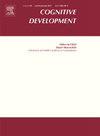Hysteresis in posture selection in preschool children
IF 1.8
3区 心理学
Q3 PSYCHOLOGY, DEVELOPMENTAL
引用次数: 0
Abstract
In a repetitive, sequential task, we tend to reuse our former motor plans to save cognitive planning cost. This reuse results in a persistence in the former posture, termed motor hysteresis. In the current study, we asked if this planning principle for cost minimization would already be present in early childhood development. To this end, we asked 4- to 6-year-old preschool children to open a column of slotted drawers in an ascending and in a descending sequence. As the dependent variable, we documented whether children used an over- or underhand grasp for each drawer. A majority of children switched from the default overhand to an underhand grasp for the lower drawers. The point-of-change shifted as a function of sequence: the children persisted in their initial, underhand grasp in the ascending and in an overhand grasp in the descending sequence. The results indicate that preschool children can inhibit the default grasp posture to adapt to the biomechanical requirements of a task and that hysteresis as a planning principle is either innate or already well developed at an early age.
学龄前儿童姿势选择的滞后性
在重复的、连续的任务中,我们倾向于重复使用我们以前的运动计划,以节省认知计划成本。这种重复使用导致前一种姿势的持续存在,称为运动迟滞。在目前的研究中,我们询问这种成本最小化的规划原则是否已经存在于儿童早期发展中。为此,我们要求4到6岁的学龄前儿童按升序和降序打开一列有槽的抽屉。作为因变量,我们记录了孩子们是用手抓还是用手抓每个抽屉。大多数孩子从默认的用手抓下抽屉变成用手抓下抽屉。变化的点随着顺序的变化而变化:孩子们坚持他们最初的,在上升的顺序中,用右手抓,在下降的顺序中,用右手抓。结果表明,学龄前儿童能够抑制默认抓取姿势以适应任务的生物力学要求,迟滞作为一种规划原则可能是先天的,也可能是在早期就已经很好地发展起来的。
本文章由计算机程序翻译,如有差异,请以英文原文为准。
求助全文
约1分钟内获得全文
求助全文
来源期刊

Cognitive Development
Multiple-
CiteScore
3.20
自引率
5.60%
发文量
114
期刊介绍:
Cognitive Development contains the very best empirical and theoretical work on the development of perception, memory, language, concepts, thinking, problem solving, metacognition, and social cognition. Criteria for acceptance of articles will be: significance of the work to issues of current interest, substance of the argument, and clarity of expression. For purposes of publication in Cognitive Development, moral and social development will be considered part of cognitive development when they are related to the development of knowledge or thought processes.
 求助内容:
求助内容: 应助结果提醒方式:
应助结果提醒方式:


